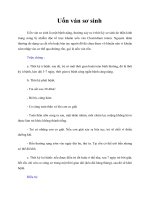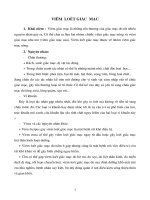Tài liệu Giáo trình: Marketing Management_ Chapter 04 ppt
Bạn đang xem bản rút gọn của tài liệu. Xem và tải ngay bản đầy đủ của tài liệu tại đây (733.57 KB, 41 trang )
4 - 1
Chapter
Chapter
4
4
Analyzing
Analyzing
Consumer
Consumer
Behavior
Behavior
4 - 2
Key Learning Points
Key Learning Points
Concept & activity of market segmentation
Concept & activity of market segmentation
Segmentation implementation issues
Segmentation implementation issues
Understanding consumer motives for
Understanding consumer motives for
buying behavior
buying behavior
Understanding how consumers make
Understanding how consumers make
purchase decisions
purchase decisions
Importance of understanding where and
Importance of understanding where and
when consumers buy
when consumers buy
Implications for global and technology
Implications for global and technology
-
-
based markets
based markets
4 - 3
Customer Analysis
Customer Analysis
Customer analysis addresses five
Customer analysis addresses five
questions:
questions:
–
–
Who are the current and potential
Who are the current and potential
customers for the product or service?
customers for the product or service?
–
–
Why do they buy?
Why do they buy?
–
–
How do they make purchasing
How do they make purchasing
decisions?
decisions?
–
–
Where do they buy the product or
Where do they buy the product or
service (what channels are used)?
service (what channels are used)?
–
–
When do they buy?
When do they buy?
4 - 4
Customer Analysis
Customer Analysis
Customer analysis should include:
Customer analysis should include:
–
–
Current customers
Current customers
–
–
Competitors
Competitors
’
’
customers
customers
•
•
Helps understand why competitors
Helps understand why competitors
’
’
products are being bought.
products are being bought.
–
–
Former customers
Former customers
•
•
Helps to understand weaknesses of your
Helps to understand weaknesses of your
product or service.
product or service.
–
–
Nonusers
Nonusers
•
•
Helps understand how to expand the market.
Helps understand how to expand the market.
4 - 5
Who Are the Customers?
Who Are the Customers?
Market segmentation is the key
Market segmentation is the key
–
–
Breaks mass markets into groups with
Breaks mass markets into groups with
unique buying habits.
unique buying habits.
–
–
Segments are useful when:
Segments are useful when:
•
•
People in different segments behave
People in different segments behave
differently toward the product.
differently toward the product.
•
•
Different marketing elements (price, etc.)
Different marketing elements (price, etc.)
can be used to effectively reach different
can be used to effectively reach different
segments.
segments.
–
–
The segmentation process makes use
The segmentation process makes use
of both primary and secondary data.
of both primary and secondary data.
4 - 6
Who Are the Customers?
Who Are the Customers?
Benefits of market segmentation
Benefits of market segmentation
–
–
More efficient than mass marketing.
More efficient than mass marketing.
•
•
Less money is wasted on low
Less money is wasted on low
probability contacts.
probability contacts.
–
–
More effective than mass
More effective than mass
marketing.
marketing.
•
•
Every aspect of the marketing mix can
Every aspect of the marketing mix can
be customized to appeal to the needs
be customized to appeal to the needs
of each segment.
of each segment.
4 - 7
Who Are the Customers?
Who Are the Customers?
Single
Single
-
-
customer segments make
customer segments make
sense in certain circumstances:
sense in certain circumstances:
–
–
Number of customers is small.
Number of customers is small.
–
–
Companies try to create perception that
Companies try to create perception that
individuals are treated as a unique
individuals are treated as a unique
group using:
group using:
•
•
One
One
-
-
to
to
-
-
one marketing, by means of
one marketing, by means of
individualized communications.
individualized communications.
•
•
Mass customization, via personalized
Mass customization, via personalized
products and services.
products and services.
4 - 8
1.
1.
What particular database fields
What particular database fields
would casino marketers use in
would casino marketers use in
developing one
developing one
-
-
to
to
-
-
one marketing
one marketing
appeals?
appeals?
2.
2.
Can you think of an example of a
Can you think of an example of a
product or service that offers
product or service that offers
consumers mass customization
consumers mass customization
opportunities? Explain.
opportunities? Explain.
Discussion Questions
Using one
Using one
-
-
to
to
-
-
one marketing
one marketing
effectively requires that marketers
effectively requires that marketers
have access to extensive databases.
have access to extensive databases.
4 - 9
Product & Service
Product & Service
Decisions
Decisions
Key Decisions
Key Decisions
Who Are the Customers?
Who Are the Customers?
Geographic and Psychographic
Geographic and Psychographic
Variables
Variables
Region
Region
City or
City or
metro size
metro size
Density
Density
Climate
Climate
4 - 9
Lifestyle
Lifestyle
Personality
Personality
4 - 10
Product & Service
Product & Service
Decisions
Decisions
Key Decisions
Key Decisions
Who Are the Customers?
Who Are the Customers?
Demographic Variables
Demographic Variables
Age
Age
Family size
Family size
Family life cycle
Family life cycle
Gender
Gender
Income
Income
Occupation
Occupation
4 - 10
Education
Education
Religion
Religion
Race
Race
Generation
Generation
Nationality
Nationality
Social class
Social class
4 - 11
Product & Service
Product & Service
Decisions
Decisions
Key Decisions
Key Decisions
Who Are the Customers?
Who Are the Customers?
Behavioral Variables
Behavioral Variables
Occasions
Occasions
Benefits
Benefits
User status
User status
Usage rate
Usage rate
4 - 11
Loyalty status
Loyalty status
Buyer readiness
Buyer readiness
stage
stage
Attitude toward
Attitude toward
product
product
4 - 12
Figure 4-1:
Global Differences: India,
China, and the United States
4 - 13
Figure 4-2:
Generational Cohorts
4 - 14
Who Are the Customers?
Who Are the Customers?
Geographic, demographic, and
Geographic, demographic, and
behavioral usage data have
behavioral usage data have
traditionally been used to form
traditionally been used to form
segments.
segments.
More recently, psychographics have
More recently, psychographics have
been combined with usage data to
been combined with usage data to
better define segments.
better define segments.
–
–
VALS2 (SRI International)
VALS2 (SRI International)
–
–
Technographics
Technographics
(
(
Forrestor
Forrestor
Research)
Research)
4 - 15
Product & Service
Product & Service
Decisions
Decisions
Key Decisions
Key Decisions
Who Are the Customers?
Who Are the Customers?
VALS2 Psychographic Groups
VALS2 Psychographic Groups
Actualizers
Actualizers
Fulfilleds
Fulfilleds
Experiencers
Experiencers
Achievers
Achievers
4 - 15
Believers
Believers
Strivers
Strivers
Makers
Makers
Strugglers
Strugglers
Visit SRI International’s website for more information
4 - 16
Figure 4-4:
Pain Reliever Use
4 - 17
Figure 4-5:
How Tech Customers
Stack Up
4 - 18
Who Are the Customers?
Who Are the Customers?
Not all consumers are equally likely
Not all consumers are equally likely
to adopt new technologies.
to adopt new technologies.
The diffusion of innovations model
The diffusion of innovations model
describes how innovations are
describes how innovations are
adopted throughout the marketplace.
adopted throughout the marketplace.
Positive word
Positive word
-
-
of
of
-
-
mouth generated by
mouth generated by
innovators is often a key
innovators is often a key
characteristic in new product
characteristic in new product
adoption.
adoption.
4 - 19
Figure 4-6:
Innovator Categories
4 - 20
Who Are the Customers?
Who Are the Customers?
Innovators:
Innovators:
–
–
First to try new products or ideas,
First to try new products or ideas,
venturesome, price insensitive, often
venturesome, price insensitive, often
technologists and beta testers.
technologists and beta testers.
Early Adopters:
Early Adopters:
–
–
Value new products as a result of how
Value new products as a result of how
they will enhance their life.
they will enhance their life.
Early Majority:
Early Majority:
–
–
Pragmatists; wait to purchase until they
Pragmatists; wait to purchase until they
are certain new products are not fads.
are certain new products are not fads.
4 - 21
Who Are the Customers?
Who Are the Customers?
Late Majority:
Late Majority:
–
–
More conservative than early majority;
More conservative than early majority;
require established product standard
require established product standard
and substantial service support.
and substantial service support.
Laggards:
Laggards:
–
–
Not interested in new technology or
Not interested in new technology or
changing current habits.
changing current habits.
•
•
Some men still shave with straight edge
Some men still shave with straight edge
razors.
razors.
4 - 22
Product & Service
Product & Service
Decisions
Decisions
Key Decisions
Key Decisions
Who Are the Customers?
Who Are the Customers?
Secondary Sources of
Secondary Sources of
Segmentation Information
Segmentation Information
www.census.gov
www.census.gov
www.freedemographics.com
www.freedemographics.com
www.mediamark.com
www.mediamark.com
www.claritas.com
www.claritas.com
In
In
-
-
class activity:
class activity:
“
“
You are where you live
You are where you live
”
”
4 - 22
4 - 23
Who Are the Customers?
Who Are the Customers?
Marketing Research Implications:
Marketing Research Implications:
Developing Target Markets
Developing Target Markets
–
–
Parsimony must be considered.
Parsimony must be considered.
–
–
Selected segmentation scheme must
Selected segmentation scheme must
statistically explain differences in
statistically explain differences in
purchasing behavior or other key
purchasing behavior or other key
variables.
variables.
•
•
Behavior =
Behavior =
f
f
(segmentation variables)
(segmentation variables)
4 - 24
Who Are the Customers?
Who Are the Customers?
Marketing Research Implications:
Marketing Research Implications:
Developing Target Markets
Developing Target Markets
–
–
Other considerations when selecting
Other considerations when selecting
one or more segments to target:
one or more segments to target:
•
•
Segment size
Segment size
•
•
Segment growth rate
Segment growth rate
•
•
Environmental factors associated with
Environmental factors associated with
the segment
the segment
•
•
Potential competitive position
Potential competitive position
4 - 25
Figure 4-7:
Simplified
Customer Behavior Model









